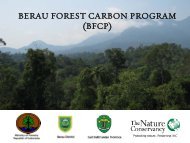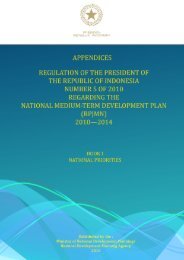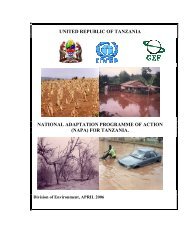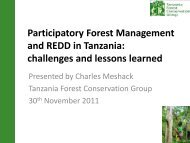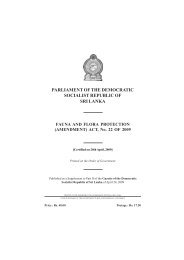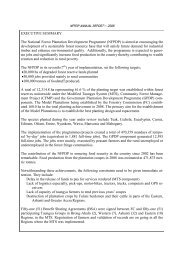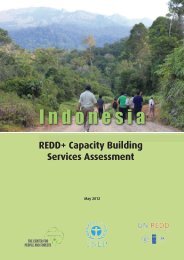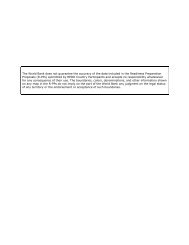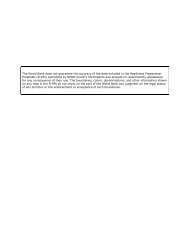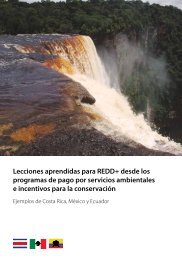Policy Impacts on Deforestation Lessons Learned ... - The REDD Desk
Policy Impacts on Deforestation Lessons Learned ... - The REDD Desk
Policy Impacts on Deforestation Lessons Learned ... - The REDD Desk
Create successful ePaper yourself
Turn your PDF publications into a flip-book with our unique Google optimized e-Paper software.
<str<strong>on</strong>g>Policy</str<strong>on</strong>g> <str<strong>on</strong>g>Impacts</str<strong>on</strong>g> <strong>on</strong> Deforestati<strong>on</strong>Less<strong>on</strong>s <strong>Learned</strong> from Past Experiences to Inform New Initiativesdeforestati<strong>on</strong> threat was low and the payments were nottargeted at threat and thus the forests receiving paymentwould largely have remained standing without payments.However, as for protected areas, looking aheadplanners could explicitly aim payments at forest facingthreats. Costa Rica’s “learning laboratory for the world”also c<strong>on</strong>firms that the details of program design can becritical. Even after the program was already in place, theevoluti<strong>on</strong> over time and space in how the payments wereallocated affected the bias towards low threat and thuspayment impact.Here, as for protected areas, it is comm<strong>on</strong> knowledgewhy ecosystem services payments might prevent deforestati<strong>on</strong>so we focus <strong>on</strong> why they might not work. Whenpayment allocati<strong>on</strong> drives of agency decisi<strong>on</strong>s, the forcesleading protected areas to be biased to lower deforestati<strong>on</strong>threats apply to payments too. And as noted, whenlandowners choose to participate, given their detailedknowledge of their own lands they can pick out parcelswith poor soil quality or slopes to offer to the paymentsprogram. Those might remain forested even withoutpayments, such that payment impacts could be low.Evaluating impacts correctly requires comparing toother similar parcels.Landowner choice raises other issues too. One large relevantgroup is households in subsistence communitieswho grow crops for their own use and also collect n<strong>on</strong>timberforest products from unprotected open-accessforest and/or locally protected community forests (Sillset al. 2003). <strong>The</strong> most valuable forest products vary byregi<strong>on</strong> and forest type, with fuelwood more predominantin arid Asia and Africa (see Arnold et al. 2006, Hyde andAmacher 2001, and Sills et al. 2003).For these landowners, if <strong>REDD</strong> policies such as paymentsyield higher-quality or more extensive foreststocks to which households have access, householdsmay be better off. <strong>The</strong>se benefits can be <strong>on</strong> the orderof several m<strong>on</strong>ths of agricultural returns (Kohlin andAmacher 2005; Kohlin and Parks 2001) including viareduced collecti<strong>on</strong> times (Cooke 1998; Cooke et al. 2008;MacD<strong>on</strong>ald et al. 2001; Arnold et al. 2006). Under thissort of scenario, <strong>REDD</strong> can bring both climate changemitigati<strong>on</strong> and adaptati<strong>on</strong> benefits, e.g., a form of naturalinsurance (Pattanayak and Sills 2001).Yet if <strong>REDD</strong> policies largely benefit private forest stocksinstead, the additi<strong>on</strong>al rent may lead to higher enforcementin, i.e., exclusi<strong>on</strong> from, private forested areas.This may not <strong>on</strong>ly decrease the welfare of subsistencehouseholds but also shift their collecti<strong>on</strong> activity to moredegraded forests (Arnold et al. 2006; Cooke St. Claire etal. 2001; Vermeulen 2001). This dynamic could also berelevant if official protected areas (see 2.1 above) are betterenforced due to <strong>REDD</strong> payments.Given these distinct possibilities, farmers could beinvolved in policy design. Arnold et al. (2006) find in areview that transfer of local wood fuel reserves to communitiescan raise access to wood as well as revenuesgovernments collect through taxes and royalties inreturn for the guarantee of property rights (see 2.4 <strong>on</strong>decentralizati<strong>on</strong>). Yet at least for fuelwood, the transacti<strong>on</strong>scosts here may be high (Hofstad 1997). Still, wenote the possibility of “participatory payments schemes.”2.2.1. Case Evidence2.2.1.1. Initial efforts. As summarized in Sills et al. (forthcoming),some early studies of pi<strong>on</strong>eering Costa RicanPSA (Programa de Servicios Ambientales) paymentsfind more forest and less agriculture <strong>on</strong> fincas (essentiallyfarms) that receive payments. Yet the paymentsprogramparticipants differ from the n<strong>on</strong>participantsin terms of characteristics that affect land use (Ortiz etal. 2003; Miranda et al. 2003; Zbinden and Lee 2005).For instance, landowners can <strong>on</strong>ly obtain PSA payments<strong>on</strong> fincas for which they can establish clear ownership,while others are more likely to clear forest just to establishsuch property rights. Thus clearing may be lower <strong>on</strong>PSA fincas for reas<strong>on</strong>s unrelated to PSA.Studies also compare forest cover in a given finca beforeand after the establishment of the PSA. A teleph<strong>on</strong>e surveyof 100 PSA landowners across Costa Rica found 43%of forest receiving payments already was protected while36% was used for grazing before the c<strong>on</strong>tract (Ortiz et al.2003). Yet even c<strong>on</strong>cerning the latter significant number,rising forest cover <strong>on</strong> PSA fincas does not necessarilymean that the increase is due to PSA. Forest covercould be already increasing due to shifts in other factors(see Brockett and Gottfried 2002; de Camino et al. 2000;Miranda et al. 2006; Sánchez-Azofeifa et al. 2007). Evaluati<strong>on</strong>sshould ideally c<strong>on</strong>trol for such time trends.A variati<strong>on</strong> <strong>on</strong> this approach to evaluating paymentimpacts is illustrated by Sierra and Russman (2006). <strong>The</strong>ystudy land use <strong>on</strong> recently enrolled properties (c<strong>on</strong>tractssigned in the last two years) to approximate what theland use <strong>on</strong> properties that had been enrolled for morethan five years would have been had there been no paymentsprogram. <strong>The</strong>y find the PSA participants in theOsa Peninsula with recent c<strong>on</strong>tracts have significantlymore land in agricultural producti<strong>on</strong> than do earlierparticipants. <strong>The</strong>y c<strong>on</strong>clude that payments allow landholdersto invest in off-farm enterprises and accelerateNicholas Institute25



